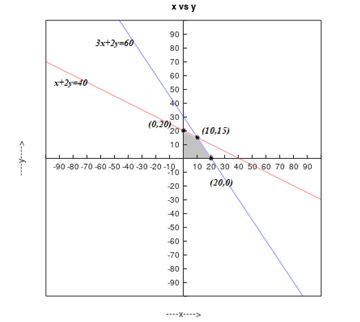
Maximizing Profil on Ice Skates A factory manufactures two kinds of ice skates: racing skates and figure skates. The racing skates require 6 work-hours in the fabrication department, whereas the figure skates require 4 work-hours there. The racing skates require 1 work-hour in the finishing department, whereas the figure skates require 2 work-hours there. The fabricating department has available at most 120 work-hours per day, and the finishing department has no more than 40 work-hours per day available. If the profit on each racing skate is and the profit on each figure skate is , how many of each should be manufactured each day to maximize profit? (Assume that all skates made are sold.)
To solve: The given linear programming problem.
Answer to Problem 27AYU
Solution:
The factory has to manufacture 10 racing skates and 15 figure skates.
Explanation of Solution
Given:
- A factory manufactures racing skates and figure skates.
- Racing skates require 6 work-hours in the fabrication department and 1 work-hour in the finishing department.
- Figure skates require 4 work-hours in the fabrication department and 2 work-hour in the finishing department.
- Fabricating department has available at most 120 work-hours per day and finishing department has no more than 40 work-hours per day available.
- Profit on each racing skate is and profit on each figure skate is .
Calculation:
Begin by assigning symbols for the two variables.
be the number racing skates manufactured.
be the number figure skates manufactured.
If is the total profit then,
The goal is to maximize subject to certain constraints on . Because represents number of skates to be produced, the only meaningful values of are non-negative.
Therefore, .
From the given data we get,
Therefore, the linear programming problem may be stated as,
Maximize, .
Subject to,
The graph of the constraints is illustrated in the figure below.

The corner points are as follows:
| Corner points are | Value of objective function |
| (20,0) | 200 |
| (10,15) | 280 |
| (0,20) | 240 |
Therefore, the factory has to manufacture 10 racing skates and 15 figure skates.
Chapter 11 Solutions
Precalculus Enhanced with Graphing Utilities
Additional Math Textbook Solutions
A Problem Solving Approach To Mathematics For Elementary School Teachers (13th Edition)
Thinking Mathematically (6th Edition)
Basic Business Statistics, Student Value Edition
Elementary Statistics: Picturing the World (7th Edition)
College Algebra with Modeling & Visualization (5th Edition)
- Find the length of the following curve. 3 1 2 N x= 3 -y from y 6 to y=9arrow_forward3 4/3 3213 + 8 for 1 ≤x≤8. Find the length of the curve y=xarrow_forwardGiven that the outward flux of a vector field through the sphere of radius r centered at the origin is 5(1 cos(2r)) sin(r), and D is the value of the divergence of the vector field at the origin, the value of sin (2D) is -0.998 0.616 0.963 0.486 0.835 -0.070 -0.668 -0.129arrow_forward
- 10 The hypotenuse of a right triangle has one end at the origin and one end on the curve y = Express the area of the triangle as a function of x. A(x) =arrow_forwardIn Problems 17-26, solve the initial value problem. 17. dy = (1+ y²) tan x, y(0) = √√3arrow_forwardcould you explain this as well as disproving each wrong optionarrow_forward
- could you please show the computation of this by wiresarrow_forward4 Consider f(x) periodic function with period 2, coinciding with (x) = -x on the interval [,0) and being the null function on the interval [0,7). The Fourier series of f: (A) does not converge in quadratic norm to f(x) on [−π,π] (B) is pointwise convergent to f(x) for every x = R П (C) is in the form - 4 ∞ +Σ ak cos(kx) + bk sin(kx), ak ‡0, bk ‡0 k=1 (D) is in the form ak cos(kx) + bk sin(kx), ak 0, bk 0 k=1arrow_forwardSolve the equation.arrow_forward
 Calculus: Early TranscendentalsCalculusISBN:9781285741550Author:James StewartPublisher:Cengage Learning
Calculus: Early TranscendentalsCalculusISBN:9781285741550Author:James StewartPublisher:Cengage Learning Thomas' Calculus (14th Edition)CalculusISBN:9780134438986Author:Joel R. Hass, Christopher E. Heil, Maurice D. WeirPublisher:PEARSON
Thomas' Calculus (14th Edition)CalculusISBN:9780134438986Author:Joel R. Hass, Christopher E. Heil, Maurice D. WeirPublisher:PEARSON Calculus: Early Transcendentals (3rd Edition)CalculusISBN:9780134763644Author:William L. Briggs, Lyle Cochran, Bernard Gillett, Eric SchulzPublisher:PEARSON
Calculus: Early Transcendentals (3rd Edition)CalculusISBN:9780134763644Author:William L. Briggs, Lyle Cochran, Bernard Gillett, Eric SchulzPublisher:PEARSON Calculus: Early TranscendentalsCalculusISBN:9781319050740Author:Jon Rogawski, Colin Adams, Robert FranzosaPublisher:W. H. Freeman
Calculus: Early TranscendentalsCalculusISBN:9781319050740Author:Jon Rogawski, Colin Adams, Robert FranzosaPublisher:W. H. Freeman
 Calculus: Early Transcendental FunctionsCalculusISBN:9781337552516Author:Ron Larson, Bruce H. EdwardsPublisher:Cengage Learning
Calculus: Early Transcendental FunctionsCalculusISBN:9781337552516Author:Ron Larson, Bruce H. EdwardsPublisher:Cengage Learning





